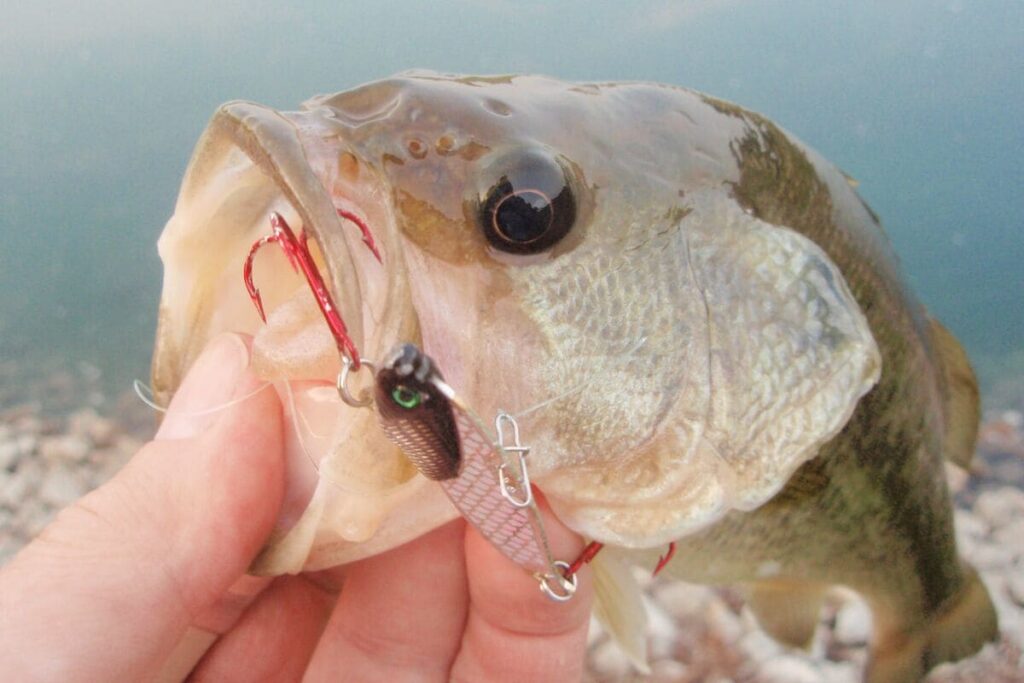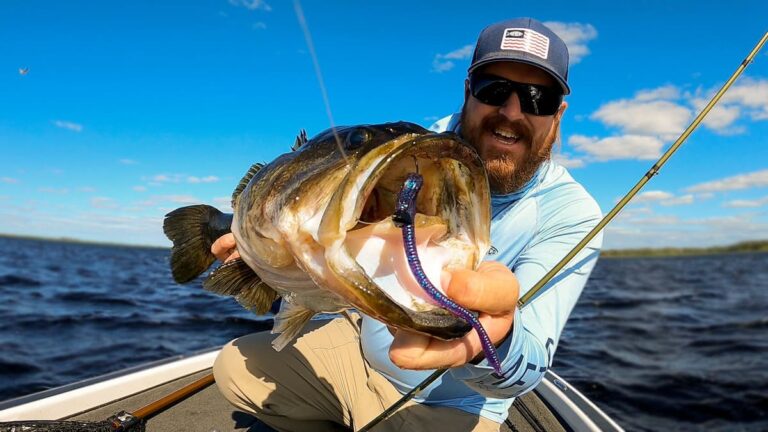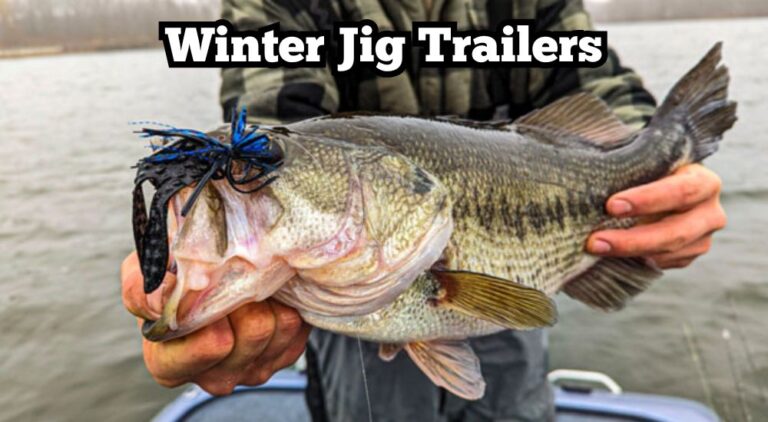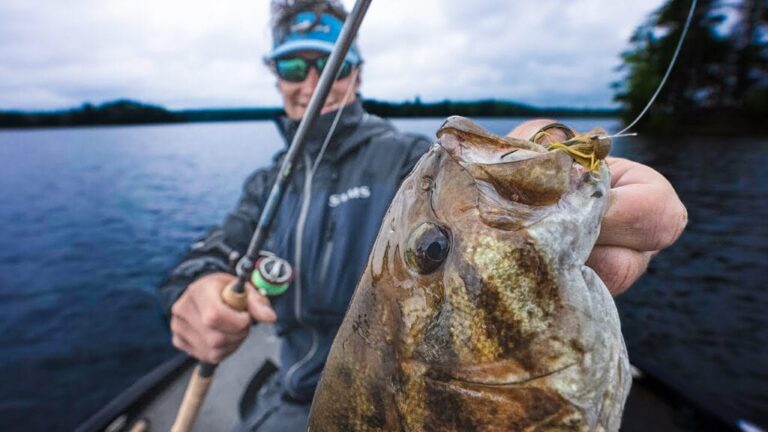How to Fish Blade Baits for Bass

Blade baits are super old and time tested lures, but have gained lots of popularity in recent years.
Although some people just see them ass a slimmer lipless crankbait, they are very different.
Blade baits are fished in very unique ways and give anglers some benefits that no other lures do.
When the winter season rolls in, almost nothing beats a blade bait for cold water bass fishing.
What is a Blade Bait?
Blade baits almost seem too simple to work. They are essentially just a slab of metal in the shape of a baitfish with a weighted belly.
They have very similar action to a lipless crankbait, but the thinner profile is more subtle and displaces less water.
Blade baits also don’t make any sound like the beads and rattles in a lipless crankbait.
The more subtle and unique profile of a blade bait is a fantastic cold water lure.
Don’t get me wrong, a blade bait can catch bass all year round, but it really shines from the late fall to the early spring.
Blade Bait Hook Styles

Classic Treble Hook
Treble hooks come standard on almost all hard-body bass lures. There is nothing super special about them.
Your hookup ratios are going to be super high because you have six hook points pointing in every directing.
If the bass bites your blade bait, they are going to get hooked. The only problem is these hooks also get snagged on cover.
Backwards Dual Hook
I am not sure why, but this style of hooks only come on blade baits. The hooks themselves are much like frog hooks.
By positioning these hooks backwards on the blade bait, there is no hook pointing forward.
So you can pull the blade bait right over wood, rocks, man-made cover, and even some grass.
As you can imagine, you are going to miss more bass with these hooks.
But the hookup ration is still quite good, and if you are targeting bass around cover, these hooks will catch you many more bass.
Feathered Hook
This isn’t really a different hook, but more of a hook modification. You can get feathered hooks in both treble and dual hook styles.
The feather adds a bit of extra action and visual appeal for bass. Feathered hooks work especially well when bass are just nipping or slapping at the bait.
Adding the feather gives them a small target to hone in on and bite a bit harder.
You will notice that lots of these bass just nip at the feather and end up getting hooked.
Swivel Snap Position
One of the defining characteristics of blade baits is three different holes in the top of the lure.
Depending on which hole you attach the swivel snap to, the bait will perform differently.
Front Swivel Hole
The front, or first hole on the blade bait will give it the tightest action. The bait will vibrate very tightly and put off less overall vibration.
This is ideal for clear water, cold water, or when you are fishing the bait faster. This is pretty standard.
The clearer or colder the water, the less action and vibration you want.
Back Swivel Hole
The back, or last hole on the blade bait will give the lure a very wide and thumping vibration.
You want to be using this presentation in muddier water or warmer water. The fish need a bit more vibration to hone in on your lure.
The aggressive, thumping vibrations work a bit better on warmer, higher energy bass.
Middle Swivel Hole
This one is your versatile option. If you aren’t really sure how aggressive bass are or your water is just a bit stained, go with the middle hole. The action will be right in the middle of tight and wide.
Rod for Blade Baits
All anglers have a bit different take on this and you will see guys using both spinning rods and casting rods.
For me, if I am using a 1/4 oz or 3/8 oz blade bait, I will probably use a spinning rod. If I am using a heavier blade bait, I’ll use the casting rod.
Line for Blade Baits
I only use fluorocarbon or braid with a super long fluorocarbon leader. Blade baits are typically cold water lures.
This means the water is going to be clearer, and bass are going to be a bit more picky.
So you don’t want them to get a look at you line at all. The fluorocarbon also has almost no stretch in it.
This is actually very important with blade baits. When ripping, bouncing, or popping the lure around, you want the blade bait to start vibrating as soon as you retrieve it.
With monofilament, the little bit of stretch will delay the action of your lure.
How to Retrieve Blade Baits for Bass
Yo-Yo
The Yo-Yo technique is exactly what is sounds like. Rip the bait up 1-2 feet and let them fall towards the bottom.
Then once the bait sinks 1-2 feet back down, rip it up again. This makes the blade bait look just like a dying baitfish.
During the winter months, bass mostly eat dying baitfish. So the Yo-Yo technique is very natural while still being able to trigger reaction strikes.
Bottom Hopping
Bottom hopping is my favorite way to fish blade baits for bass. Let the lure sink all the way to the bottom and just hop it up and down, letting it sink back to the bottom after each hop.
This is almost like hopping a jig on the bottom, but it gives you a cold water baitfish presentation.
If your lake or pond has lots of leaves on the bottom, use the frog style hooks. These will prevent your bait from snagging the leaves and ruining all your casts.
Straight Reel
The straight reel retrieval is much less common, but does have its place. This works best in very clear, shallow water.
It is almost like burning a spinnerbait around. The quick vibration and flash will get aggressive clear water bass to strike.
The blade bait will outperform a lipless crankbait, because it is silent and can be fished faster when using the front swivel attachment.
Tying this Off
If you have had a tough time catching cold water bass, give the blade bait a try.
Although there are many logical and scientific reasons that blade baits work great in winter, they also just seem to have that X factor that gets tons of bites.
The simplicity and effectiveness of these lures makes them highly effective and intriguing lures for us fisherman.
Get out on the water and test them out for yourself!






